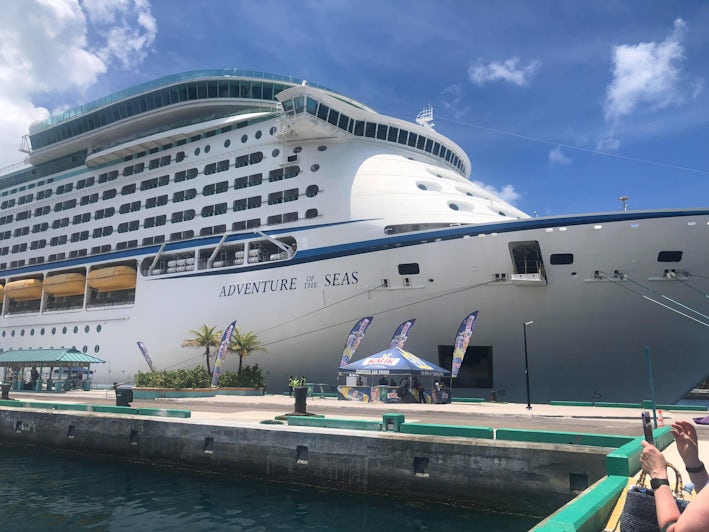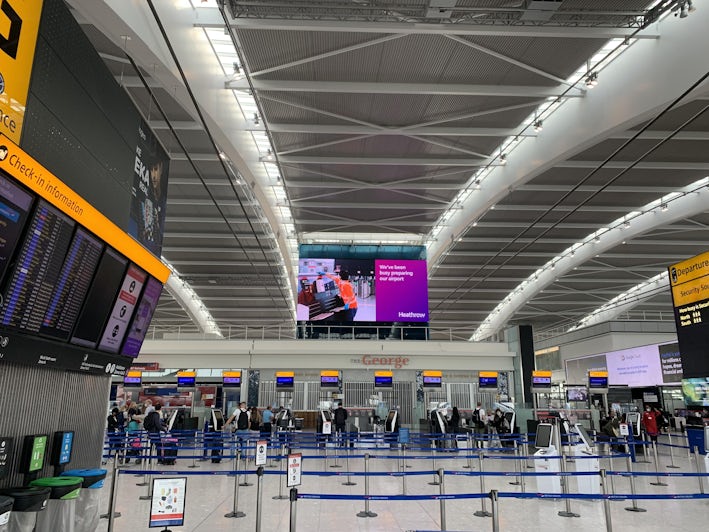
5 Things You Need to Know About Cruising From an International Port



Cruising is underway, with many cruise lines leaving from international ports around the world. It's exciting to travel to new, exotic places to hop on a cruise ship, but in this pandemic era, it's important to keep a few things in mind.
On This Page
1. You Should Print Out Documents.

Cruise lines long have been moving toward a friction-free travel experience, complete with apps (more on those later) designed to serve as your boarding pass. But when it comes to heading to new international ports, like St. Maarten, Greece, The Bahamas and Iceland, you should know that destinations have different requirements.
Some need to see your vaccination card. Others require PCR tests. Some destinations require pre-arrival approval. And visas. It's a lot, and it's new.
Cruise lines do a good job of providing updates on everything you will need to get to (and through) your international port destination, often creating checklists with handy links to relevant sites, sent directly to your email inbox. Keep your checklist handy, and print off all those documents they're asking for. When it comes to PCR tests, have two copies for each traveler, just in case you need one for the airport and one for the hotel or ship. Make a copy of your vaccination card, but bring the original as well. And print out any approval documents.
We traveled to St. Maarten for a cruise on Celebrity Millennium, and people who had electronic versions of their required Electronic Health Authorization System approvals slowed things down trying to pull up the approvals on mobile devices where internet was slow. (Electronic versions of the form were allowed -- it even said this when you applied -- but those with paper forms kept things moving and zipped through.)
Same with The Bahamas, where we cruised from Nassau on Adventure of the Seas. Printed forms of the documents sped everything up.
We've also printed out QR codes needed to get into Greece. These were checked but not scanned.
2. You Need to Think About Airport/Airline Rules, Too.

If you're typically a domestic traveler, your airport and airline rules tend to be dictated by federal and company regulations, so they're mostly the same from place to place.
Not so with international airlines. We showed up to the airport to board our Lufthansa flight to Athens, with a stop in Munich, and were told at boarding we needed a KN95 mask or surgical mask, rather than the cloth ones we had. That meant a trip to the nearest shop to quickly buy overpriced KN95 masks ($3 per!). My mask strap snapped about 30 minutes into my flight, and thankfully, the flight attendant had spare surgical masks. I replaced my damaged mask, then found out at the airport in Munich you must have a KN95 to get into any shops, restaurants or lounges. Another 2 euros for that, and I'm wistfully thinking about my box full of KN95s sitting at home.
Check your airline's rules ahead of your flight, and fill out any additional questionnaires you might see. It might ask you to scan your passport or proof of negative COVID test or vaccination. Some airlines are using external apps now like VeriFLY; United also allows you to upload copies of any visas, COVID-19 tests or vaccine cards and this made things much easier flying between Newark and The Bahamas . Save yourself the hassle and read the regulations closely. We were asked for our vaccination cards at our home airport and again at customs and immigration in Germany.
Despite your best efforts, though, you might discover you're unable to check in for your flight before heading to the airport. Make sure you give yourself plenty of time the day you fly to check in if necessary and maneuver though airport security.
3. Some Airports Aren't Set Up For This New Traffic Rush.
Ports cities like Athens are accustomed to cruise passengers coming in and out of the city in droves. But others, like St. Maarten and Nassau, are new to homeporting. In addition to hosting cruise passengers, these islands also have travelers who just come to stay on land as well. That's a lot of people coming through those airports.
On our cruise from St. Maarten, which embarked and disembarked on Saturdays, we found arrival to be an efficient process -- we were through the airport in less than an hour. But on our way out, the airport was clearly overwhelmed by people. A couple of issues played into this, including the policy not to allow passengers to enter the airport more than three hours before their flights were due to leave. That meant a lot of passengers who left right from the cruise ship in the morning but had afternoon flights were left baking in the hot sun waiting to get inside. And inside was even more troublesome: The small airport was managing so many outgoing flights -- often leaving within 10 to 15 minutes of one another -- that it was standing room only for hours. Lines crisscrossed, announcements were difficult to hear and communication was spotty. Our flight left more than an hour late, and at least 60 percent of passengers ended up missing their connecting flights, making plans late at night for rebookings the next day or beyond.
The Bahamas ended up being a better experience. But -- and this is a big but -- the people who ran into problems were those who decided to fly in the same day as embarkation. It's even more important to fly in the day before, if possible, and spare yourself the stress.
If you're planning to sail from an international port, especially a smaller port, make sure you know what the rules are for your airport and be prepared. We heard about some cruise passengers who booked day-passes at hotels so they could hang out poolside rather than with the throngs at the airport.
Better yet: If you can swing it, fly out the day after your cruise ends, so you can skip Saturdays, often the busiest for travelers to these countries. If you do that, make sure you take your necessary COVID-19 test to re-enter the U.S. on the last day that it's offered, usually a Friday, so it's still valid for your flight.
4. Apps Are Your Friend.

Yes, you should print out documents, but you should also make sure you have apps for your airline and cruise line. Download them at home, before you're dealing with potentially spotty internet.
Your airline app will help you check in, but it also will guide you through the process of what you might need as far as documentation at various ports. For example, for our trip to Athens, we flew through Munich, which had a requirement of either proof of vaccination or a negative PCR test, and we learned much of the details on this through our airline app. We were prepared with all the right paperwork when we went through immigration in Germany, even though Greece had no such requirements.
We also loved the Celebrity App, which is much improved over the last time we sailed with Celebrity, now several years ago. The ability to create a digital express pass, fill out the health questionnaire on the app and even complete the virtual part of the muster drill ahead of boarding all helped get us quickly through the check-in process in international ports.
Royal Caribbean's app wasn't quite as straightforward. We also downloaded the TrustOne app, which is the provider of the COVID-19 tests that we needed to take. Our results showed up on the app well before we received notice in our room.
5. Your Cruise Line is Beholden to the Ports it Visits

In international ports, the cruise lines set their rules. But they do so in conjunction with the port from which the ship embarks. So, in St. Maarten, where rules about masks have been eased, masks weren't required onboard Celebrity Millennium. In Athens, though, masks are still a part of everyday life. Consequently, sailings that left from that port on Celebrity Apex had a requirement that all passengers wear masks. As restrictions change in ports, so too will they change onboard.
The Bahamas had similar requirements. Masks are required indoors and outside, and we saw the police gently chiding people without them. Plus, you need to show your vaccine card to eat inside a restaurant and everyone has a 10 p.m. curfew.
It's not just the homeports, though, that can affect your cruise. Ports visited by cruise ships influence policies and even itineraries. If there is an outbreak in a port or if rules change -- get tighter or looser -- you can expect it will affect your sailing. It might mean that you suddenly have to get a PCR test, or that you need a PCR test within a shorter window.
We saw both happen on Celebrity Millennium, when Barbados changed its policies around PCR requirements. It originally was scheduled to be the final stop of a weeklong cruise. But its tight PCR requirements saw Celebrity shifting its spot on our itinerary, to the top. It also meant that the 120-hour window for PCR testing originally required to get onboard shrunk to 72 hours, and passengers scrambled to get new tests scheduled. Most were able to do so without significant disruption, but it required some nimble maneuvering.
Ultimately, none of these factors about international cruising should stop you from sailing; if you're like us, you've been itching to get back onboard cruise ships for months. Just know that you'll have the smoothest vacation if you're both prepared and flexible. It's likely things will change, but if you can go with the flow and recognize potential pinch points early on, modifications won't slow you down.